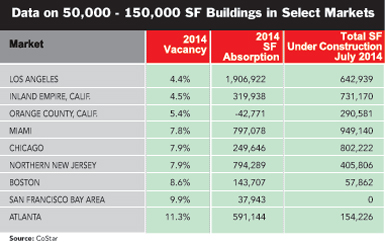Companies snapping up existing spaces include food- and construction-related users, as well as small manufacturers, suppliers, and distributors involved in consumer packaging, metal fabrication, medical supplies, and plastics for consumer products. Positive absorption is attributable to a growing confidence among tenants and owner-occupiers that are leasing manufacturing, distribution, and flex buildings at an accelerated rate.
Transwestern analysis of second-quarter 2014 CoStar data finds a rise in demand for 50,000- to 150,000-square-foot buildings in Los Angeles; California’s Inland Empire; Orange County, California; Miami; Chicago; northern New Jersey; Boston; the San Francisco Bay area; and Atlanta. A prime development market, Los Angeles has a 4.4 percent vacancy rate on a total inventory of 289.5 million square feet but only 642,939 square feet under construction in this category. Northern New Jersey has only 405,806 square feet under construction, though it has a 7.9 percent vacancy rate on inventory of 249.7 million square feet. And nothing of this size is reported as under construction in the San Francisco Bay Area, despite a 9.9 percent vacancy rate on a 204.2 million-square-foot inventory.
Expect to see more speculative and build-to-suit development of small-scale facilities as absorption rates increase. This type of development has not occurred for eight to 10 years. It will bring state-of-the-art buildings to market featuring higher clear heights, trailer parking, speed bays, wider column spacing, and ESFR sprinkler systems. Urban infill sites or tracts near airports likely will be prime development targets since many of the entrepreneurs driving this demand want a short commute. In addition, the anticipated development activity could become a buying opportunity for investors that target small-scale facilities, users who want to own their properties, or institutional investors that want to expand in a market or acquire a portfolio of properties.
